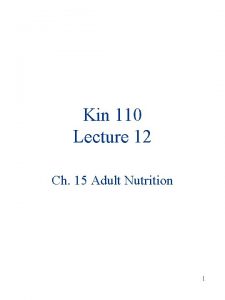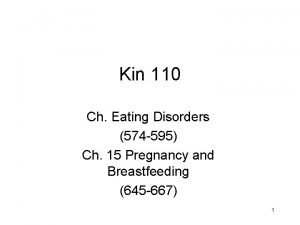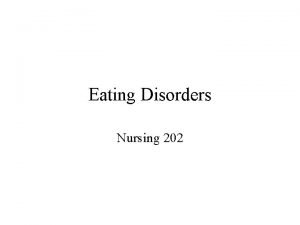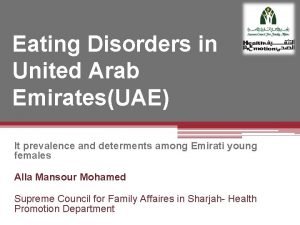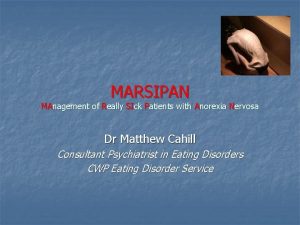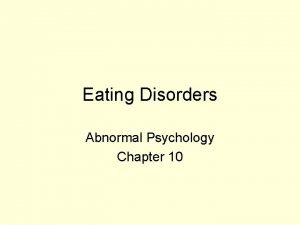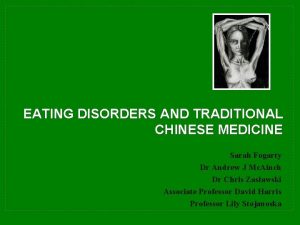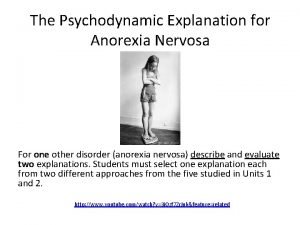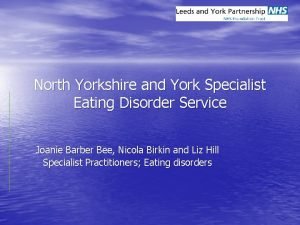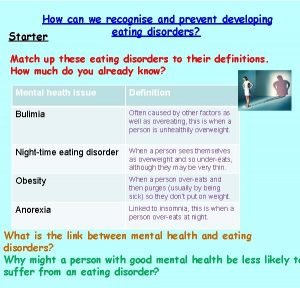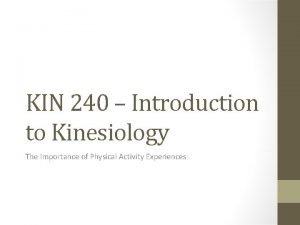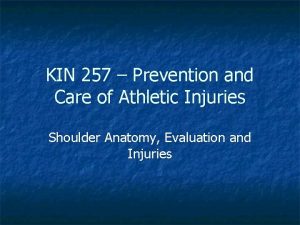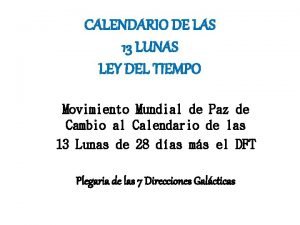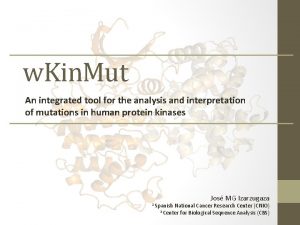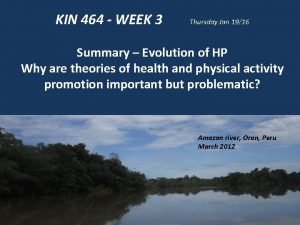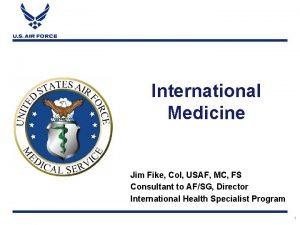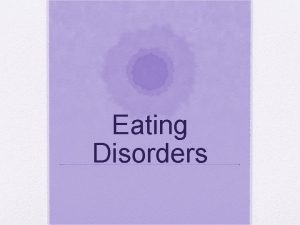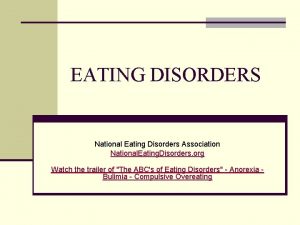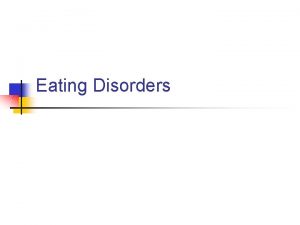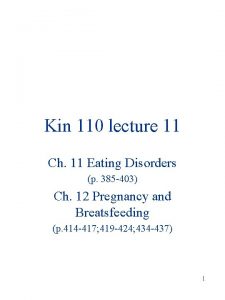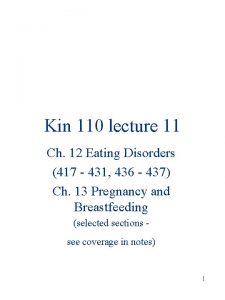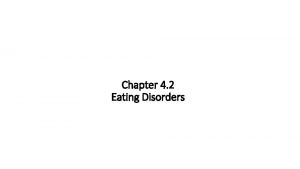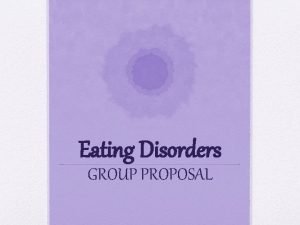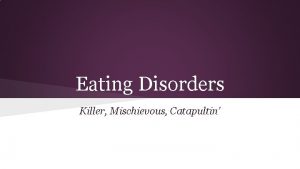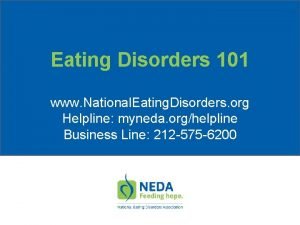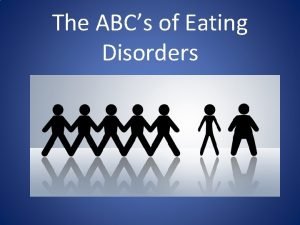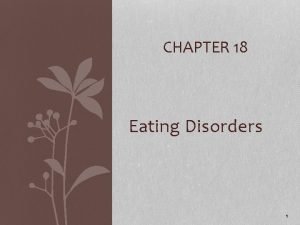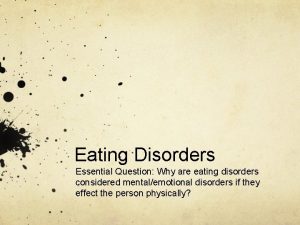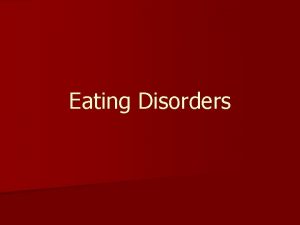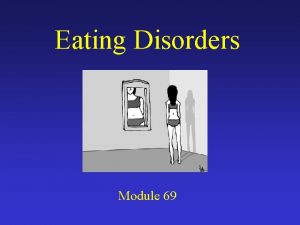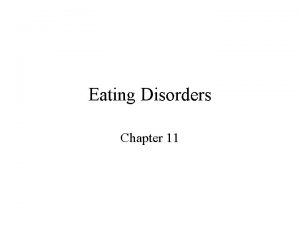Kin 110 Ch Eating Disorders 574 595 Ch






















































- Slides: 54

Kin 110 Ch. Eating Disorders (574 -595) Ch. 15 Pregnancy and Breastfeeding (645 -667) 1

Eating Disorders • Eating serves psychological, social and cultural purposes • Media bombards us with ‘ideal’ body types • may develop unhealthy relationship with eating, obsessive weight loss and strange rituals around food • Food often linked with personal and emotional experiences 2

This Is In • In 1998, Mattel overhauled Barbie’s look for the millennium, giving her slimmer hips, a wider waist, and smaller breasts. • Barbie’s periodic overhauls are meant to fit the fashion of the times. 3

Eating Disorders • Disordered eating - temporary or mild change in eating patterns • Eating disorders - illness that can seriously interfere with daily activities - persistent inability to eat in moderation • The eating disorder continuum 4

Eating Disorders: No Simple Causes • Predisposition • Social factors – Expectations for body size, shape • Psychological factors – Peer relationships, family expectations, emotional trauma • Biological factors – Neurotransmitter levels • Genetic factors – Synthesis and release of leptin, orexin 5

Anorexia Nervosa • psychological loss or denial of appetite and self starvation, related in part to distorted body image and various social pressures associated with puberty • extreme weight loss, irrational fear of obesity and weight gain • Diagnostic criteria – Body weight < 85% of expected (BMI 17. 5 kg/m 2) – Intense fear of weight gain – Distorted body image – Amenorrhea 6

BMI and Underweight 7

Anorexia Nervosa • Profile - competitive, obsessive, parents set extremely high standards • hypergymnasia - excessive exercise • early warning signs - rituals with food • cook large meals for others, not self 8

Warning Signs of Anorexia 9

Side Effects of Excessive Weight Loss in Anorexia Nervosa • Neuropsychiatric – Abnormal taste sensation – Depression – Impaired thought process • Cardiac – Loss of cardiac muscle, resulting in a smaller heart – Abnormal heart rhythm – Increased risk of sudden death 10

More Side Effects • Hematological – Leukopenia (abnormal decrease of white blood cells) – Iron-deficiency anemia • Gastrointestinal – Delayed gastric emptying – Bloating – Constipation – Abdominal pain 11

The Progression of Anorexia 12

Anorexia Nervosa: Treatment • Goals – Stabilize physical condition – Convert patient into participant • Restoring nutritional status • Gradual weight gain • Psychotherapy – Individual – Group – Family 13

Bulimia Nervosa • college age young adults • large quantities of food are eaten at one time (binge) and then purged from the body by vomiting, laxatives or other means • difficult to recognize, outer appearance is normal, self reported • Diagnostic criteria – Recurrent binge eating – Recurrent purging, excessive exercise, fasting – Excessive concern about weight, shape – Absence of anorexia nervosa 14

Bulimia Nervosa: Binge/Purge Cycle • Binge: large amount of food, short period of time – High-calorie, high-fat foods • Purge – Affects fluid and electrolyte balance – Can be lifethreatening 15

Bulimia Nervosa: Treatment • Medical • Nutritional • Psychotherapy – Antidepressant medications 16

Binge Disorder • Compulsive overeating – binge episodes without purging at least twice per week • may not deal with emotional problems effectively • never learned appropriate ways to deal with feelings • Should learn to eat in response to hunger • avoid sliming diets initially • generally require professional help. 17

Binge-Eating Disorder • Diagnostic criteria – Recurrent binge eating – Distress over eating behaviors – No recurrent purging – Absence of anorexia nervosa • Triggers of binge eating – Stress – Conflict – Frequent dieting 18

Binge-Eating Disorder: Treatment • Psychotherapy – Antidepressant medications • Long-term support 19

Preventing eating Disorders • Some concern about diet, health and weight is normal • some fluctuation in weight and appetite is normal • *large changes consult physician • Discourage restrictive diets, meal skipping and fasting • provide information about the normal changes with puberty • correct misconceptions about • nutrition, body weight, weight loss 20

Preventing Disorders • Carefully phrase weight related comments/recommendations • encourage normal expression of disruptive emotions • encourage children to eat only when they are hungry • provide adolescents with some choices and selfaccountability • Increase self acceptance • Enhance tolerance for diversity in body weight and shape • Emphasize that thinness is not necessarily 21 associated with better athletic performance

Eating Disorders: Related Issues • Males: an overlooked population – Fewer instances than females – Men involved in sports, modeling, entertainment • Pressure for certain weight, shape • Anorexia athletica – Sports-related eating disorders – Body size/shape important in competition – Pressure from coaches 22

Other Eating Disorders • Female Athlete Triad • high percentage of female athletes exhibit disordered eating patterns • coupled with irregular menstruation – ammenorhea • loss of bone mass - osteoporosis • treatment – – decrease preoccupation with food increase meals rebuild body establish regular menstruation 23

Eating Disorders: Related Issues • • Vegetarianism and eating disorders Smoking and eating disorders Baryophobia Infantile anorexia 24

Scary Statistics • About 5 million Americans have anorexia nervosa, bulimia, or bingeeating disorders. • Researchers estimate that 15 percent of young women have disordered eating attitudes and behaviors. • Every year an estimated 1, 000 people die from anorexia nervosa. 25

ADA: Nutrition Intervention • It is the position of the American Dietetic Association (ADA) that nutrition education and nutrition intervention, by a registered dietitian, is an essential component of the team treatment of patients with anorexia nervosa, bulimia nervosa, and eating disorders not otherwise specified (EDNOS) during assessment and treatment across the continuum of care. 26

Pregnancy Overview • Special considerations for time of life • illustrates larger importance of nutrition on body functioning • Important to plan pregnancy – modification of lifestyle – adequate nutrition – prevent fetal and infant problems • + 300 kcal per day – milk, meats and alt. – Iron, calcium, and folate (600 ug/day) • breastfeeding 27

Pregnancy – Nutrition before conception • Risk assessment, health promotion, intervention • Weight – Maintain a healthy weight • Vitamins – 400 micrograms supplemental folic acid/day – in addition to folate intake in diet » total of 600 ug recommended – Avoid high doses of retinol • Substance use – Eliminate prior to pregnancy Photo © Photodisc 28

Pregnancy • Physiology of pregnancy – Stages of human fetal growth • Blastogenic stage: first 2 weeks – Cells differentiate into fetus, placenta • Embryonic stage: weeks 3– 8 – Development of organ systems • Fetal stage: week 9—delivery – Growth • nourished until birth by placenta – – organ formed in mothers uterus oxygen and nutrient exchange fetal waste removal release of hormones of pregnancy 29

Early Growth • Hyperplasia – increase in cell number • Hypertrophy – increase in cell size • 3 weeks – specialized organs and body parts begin to form – * many women still do not know they are pregnant* • 13 weeks – heart is functional, most organs formed, fetus can move 30

First Trimester • 9 months broken into three sections, trimesters • first trimester is critical time – spontaneous abortion, ~1/3 • miscarriage – genetic defects or fatal error in fetal development • very important to avoid harmful substances and maintain adequate nutrition – nutritional deficiencies transferred through placenta 31

Second Trimester • Fetus weighs ~ one ounce at beginning of second trimester • limbs fully formed, has ears and begins to form tooth sockets • fetal heart beat can be detected with stethoscope • begins to look like infant, formed bones, can kick, suck its thumb • mothers breast weight inc. 30% • under nutrition can impair ability to breast feed 32

Third Trimester • Weighs 2 -3 lbs. At beginning • Fetus will deplete iron stores and blood glucose of mother • infants born after 26 weeks have a good chance of survival in nursery – difficulties suckling and swallowing • 9 months – 7 -9 lbs. (3 -4 kg) 50 cm long – soft spot where skull bones will fuse (12 -18 months) 33

Pregnancy • Physiology of pregnancy – Maternal changes • Growth of adipose, breast, uterine tissues • Increase blood volume • Slower GI motility 34

Nutrient Needs • emphasis is on increased nutritional requirements – individual assessment of requirements and counselling • Energy Needs • + 300 kcal / day – in 2 nd and 3 rd trimesters ( 2 cups low fat milk and piece of bread) • nutrient dense foods, increased nutrient requirements vs kcal • vitamin and mineral needs increase 20 -100%; kcal 15 % 35

Weight Gain • If active, add extra kcal for exercise to total intake – Walking, cycling, swimming recommended activities – specific precautions • Weight gain one of best predictors of pregnancy outcome – 2 - 4 lbs. in first trimester –. 75 - 1 LB per week, 2 nd and 3 rd – total gain 25 -35 lbs. (BMI ~20 -26 kg/m 2) • Depends on BMI - Table 15. 3 – fig 15. 7 • Requires regular monitoring • weekly record, allows for adjustments 36

Weight During Pregnancy • Overweight and obese women have increased risks of several problems, including preterm delivery and stillbirth. • In addition, obese women are at higher risk for – high blood pressure – gestational diabetes (a form of diabetes that is associated with pregnancy; it often is controlled through diet alone) – preeclampsia (a condition marked by high blood pressure, fluid retention, and protein in the urine) – prolonged labor – unplanned cesarean section – difficulty initiating and continuing breastfeeding 37

Specific Nutrients • RDA for protein • Increase 10 - 15 g – many already over this – important to check, – role of protein? • Carbohydrates – 100 g / day to prevent ketosis(avg 200) • vitamins • most increase slightly - B vit +30% – B 6 + 45% • Folate (RDA 600 ug) + 50% – synthesis of DNA, rbc formation – folate rich fruits and veg, fortified cereals 38

Mineral Needs • Iodide - 220 mg • IRON • 2 times the RDA in last two trimesters (30 mg/day) • hemoglobin synthesis – *fortified breakfast cereals* – attention to nausea and absorption (caffeine, dairy can inhibit absorption) • With severe iron deficiency, LBW, and risk of fetal death 39

Mineral Needs • Calcium – adequate mineralization of fetal skeleton and teeth in 3 rd tri – increase intake with conception – 1200 - 1500 mg (milk group) • Zinc – growth and development – Increase 35 % above RDA – Protein rich foods in healthy diet should supply this 40

Vegetarian Mothers • Lacto ova or lacto should have no special concerns, with earlier recommendations in mind • Iron supplementation • Vegans • focus on protein, vitamins D, B-6, B-12, iron and calcium • increase grains, beans nuts and seeds • Avoid Ketosis - difficult for fetal brain to utilize • need iron and calcium supplementation as these are difficult to absorb from plant sources 41

Pregnancy: GI Distress 42

• • • Activity Recommendations American College of Obstetrics and Gynecology Do not allow HR to exceed 140 Avoid exercise in hot, humid weather Discontinue exercise if discomfort or overheating results Drink plenty of liquids After month 4 do not exercise while lying on your back Avoid abrupt decrease in exertion - must warm down Engage in weight training only if done consistently prior to pregnancy Do not push flexibility training very hard - gentle 43 and relaxing

Lactation • Physiology of lactation • Changes during pregnancy – Increased breast tissue – Maturation of structure • Hormonal controls – Prolactin: stimulates milk production – Oxytocin: stimulates milk release • “Let-down” reflex 44

Lactation • Nutrition for breastfeeding women – Energy and protein • Higher needs than pregnancy – Vitamins and minerals • Most are higher or same as pregnancy • Iron and folate needs are lower – Water • Food choices • Practices to avoid while breastfeeding – Alcohol, drugs, smoking, excess caffeine 45

Lactation • Benefits of breastfeeding – Benefits for infants • Optimal nutrition • Reduced incidence of respiratory, GI, ear infections • Convenience • Other benefits – Benefits for mother • Convenience • Enhanced recovery of uterus size • Other benefits 46

Nutrition of Milk • Asses adequate intake by monitoring wetness and stool production • supplements with formula may be needed and are OK • should not start before breastfeeding is well established • important differences from cows milk (wait 1 year) – casien - protein difficult to digest – different minerals and carbohydrates 47

Nutrition of Milk • Colostrum – first product of breast • antibodies – compensate for immature immune system – promotes intestinal health of infant • Mature Milk – after a few days, very different from cows milk 48

Mature Milk • Main proteins form a soft light curd in GI • binds iron and reduces bacterial growth • high in essential fatty acids and fats needed for brain development • DHA, visual acuity and nervous system development (omega 3) 49

Mature Milk • Composition changes • increased fat content with feeding, should last 20 min. to get good growth and infant satisfaction • can supplement up to 4 ounces of water / day 50

Food Plan and Breastfeeding • Only slightly different from pregnancy • no longer require iron, folate • increased need for energy, vit. A, E and C, riboflavin, copper, chromium, iodide, magnanese, selemium and zinc • * increase milk group intake* – Especially teens • should maintain balanced diet, moderate fat content, maintain fluid intake • avoid crash diets 51

Attributes of Breast Feeding • Requires ~ 800 kcal /day – recommend increase only 500 kcal per day – facilitates return to pre-pregnancy weight • breast feeding enhances reduction of uterus • may prevent breast cancer if maintained for several months • Facilitates bonding with infant • Establishes habit of eating in moderation for infant • Proper development of jaws and teeth • May reduce risk of certain disorders in baby – Table 15. 7 52

Promoting and Supporting Breastfeeding • It is the position of the American Dietetic Association (ADA) that exclusive breastfeeding provides optimal nutrition and health protection for the first 6 months of life, and breastfeeding with complementary foods for at least 12 months is the ideal feeding pattern for infants. Breastfeeding is also a public health strategy for improving infant and child health survival, improving maternal morbidity, controlling health care costs, and conserving natural resources. 53

ADA: Key Recommendations • Women of childbearing age who may become pregnant. Eat foods high in heme iron and/or consume iron-rich plant foods or iron-fortified foods with an enhancer of iron absorption, such as vitamin C-rich foods. • Women of childbearing age who may become pregnant and those in the first trimester of pregnancy. Consume adequate synthetic folic acid daily (from fortified foods or supplements) in addition to food forms of folate from a varied diet. 54
 Kin 110
Kin 110 Kin 110
Kin 110 Numero niss
Numero niss 011 101 110
011 101 110 574 in expanded form
574 in expanded form 574-173-443
574-173-443 Eating disorder nursing diagnosis
Eating disorder nursing diagnosis Eating disorders in uae
Eating disorders in uae Marsipan criteria
Marsipan criteria Kate moss anorexia
Kate moss anorexia Sarah fogarty
Sarah fogarty Hilda bruch
Hilda bruch Eating disorder in which people overeat compulsively
Eating disorder in which people overeat compulsively Chimpanzee eating termites
Chimpanzee eating termites How to be anorexic
How to be anorexic Yorkshire centre for eating disorders
Yorkshire centre for eating disorders Chapter 18 eating and feeding disorders
Chapter 18 eating and feeding disorders How to spot eating disorders
How to spot eating disorders Cit 595
Cit 595 Ece 595
Ece 595 Power 720 cpw
Power 720 cpw Opwekking 349
Opwekking 349 Art 595
Art 595 595 lexile score
595 lexile score Charlotte kin
Charlotte kin Kin 240
Kin 240 Khi cho nam châm chuyển qua một mạch kín
Khi cho nam châm chuyển qua một mạch kín Dr kin tsui
Dr kin tsui Kin 303
Kin 303 Kin 240
Kin 240 Liikunnan perusopinnot
Liikunnan perusopinnot Kin 257
Kin 257 Kin 464
Kin 464 Coropitive
Coropitive Pinna acoustics
Pinna acoustics Kin tes
Kin tes D kin
D kin Linh kin
Linh kin Kin 240
Kin 240 13 lunas kin maya
13 lunas kin maya Chấn thương ngực kín slide
Chấn thương ngực kín slide Svm kernel
Svm kernel Kin 464
Kin 464 Logo kin
Logo kin Hamilton's rule
Hamilton's rule Kin games
Kin games Kin policing
Kin policing Kin-ball règles
Kin-ball règles William hamilton kin selection
William hamilton kin selection Biểu diễn số chấm động
Biểu diễn số chấm động Wong kin man
Wong kin man Cpit 110
Cpit 110 Csce 110 tamu syllabus
Csce 110 tamu syllabus Csct-110
Csct-110 Afji 48-110
Afji 48-110
